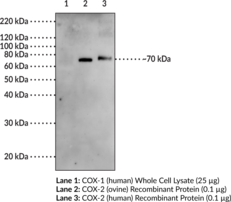Description
CD36 is a type-B scavenger receptor that is necessary for the formation of foam cells and thereby atherosclerotic lesions.{7719,9800,9801,9795} This membrane glycoprotein can internalize fatty acids which activate PPARγ and stimulate further expression of CD36.{9798,8499} This positive feedback loop combined with the murine CD36 knock-out studies reinforces the importance of CD36 in lipid metabolism. Additionally, CD36 is needed for the phagocytosis of P. falciparum infected erythrocytes, retinal pigment epithelial cell photoreceptor fragments, and post-apoptotic monocytes and neutrophils.{9794,9310,9793,9791} CD36 expression has been monitored during hematopoietic cell differentiation and may be an indicator of tumor spreading in lymphocytic leukemia.{9797} Positive controls include cells from adipose and heart tissue, platelets, and macrophages. Cayman Chemical’s CD36 Monoclonal Antibody (Clone JC63.1) is recommended for flow cytometry on CD36-containing cells of murine, rat, and human origin. The antibody can also be used to antagonize CD36-mediated cellular activity. Functional blocking inhibits CD36 binding of oxLDL (macrophages) and prevents foam cell formation of macrophages.
Synonyms: GPIIIb|GPIV|Hexarelin Receptor|oxLDL Receptor|Thrombospondin Receptor
Immunogen: Adenovirus expressing full-length recombinant mouse CD36
Formulation: 100 µg of protein L purified IgA
Isotype: IgA
Applications: FC
Origin: Animal/Mouse
Stability: 365 days
Application|Flow Cytometry||Product Type|Antibodies|Monoclonal Antibodies||Research Area|Cancer||Research Area|Cardiovascular System|Blood|Erythrocytes & Hemoglobin||Research Area|Cardiovascular System|Cardiovascular Diseases|Atherosclerosis||Research Area|Cardiovascular System|Lipids & Lipoproteins|Lipoproteins||Research Area|Immunology & Inflammation|Innate Immunity|Phagocytosis||Research Area|Infectious Disease|Parasitic Diseases|Malaria||Research Area|Oxidative Stress & Reactive Species|Lipid Peroxidation



